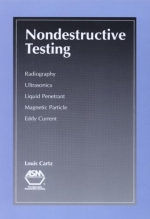Tab Article
Problems and defects of all kinds arise in the development and use of mechanical devices, electrical equipment, hydraulic systems, transportation mechanisms and the like. However, an extremely wide range of nondestructive testing (NDT) methods are available to help you examine these different problems and various defects in an assortment of materials under varying circumstances. It is imperative that you select the best method to solve a particular problem. And that requires a sufficient understanding of the basic processes involved to realize the advantages of each NDT method available.
In addition to practical hints and pertinent comments for the resolution of day to day problems, this book will give you sufficient basic theory to comprehend the principles of each method so that the most appropriate can be selected and used to its fullest advantage. Typical illustrative calculations and a comprehensive bibliography are provided.
This book will be particularly useful to advanced technicians involved with high level III NDT training, engineers concerned with quality control, general scientists and technologists dealing with materials problems but who are not NDT specialists, and engineering students taking a course in NDT.


